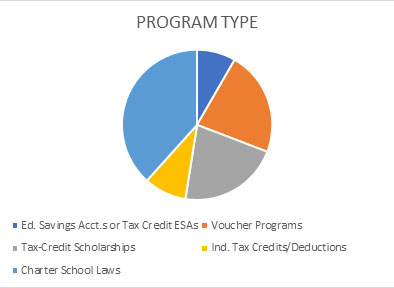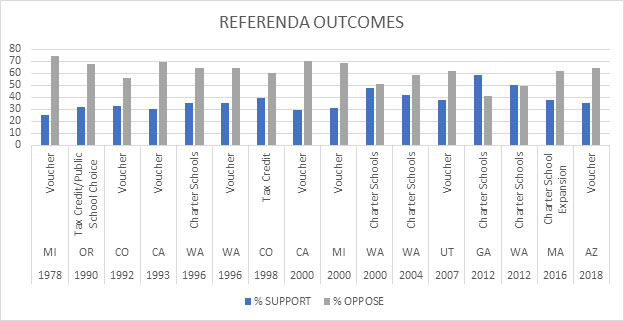
(Un)successful Strategies for Implementing School Choice
Summary
Efforts to implement school choice policies such as charter schools and vouchers are popular with lawmakers, but are almost always rejected - often by overwhelming margins - by voters.
Arizona lawmakers recently passed a universal voucher plan that allows families to send their children to private schools at taxpayer expense. Michigan legislators may also get the opportunity to implement a similar plan for over a million children in Michigan. But in these and almost all other cases, successful school choice advocacy avoids voters.
Although school choice advocates often point out that these programs are popular with parents, voters are another story. In Arizona, the electorate rejected a similar move by policymakers by a 2 to 1 margin in 2018, so last year advocates successfully prevented voters from weighing in again on the issue. In Michigan, voters have rejected voucher referenda every 22 years since 1978.
But last year voucher advocates tried using an obscure quirk in state law to by-pass a referendum and put the initiative directly to the GOP-run legislature (thereby also pre-empting a guaranteed veto from the Democratic Governor).
These two recent efforts exemplify voucher advocates’ preference for legislative over popular channels. Some 122 school choice programs (including charter schools and vouchers) exist in the US.

But on only sixteen occasions since the late 1970s have any such programs been put before voters. The only instances where voters approved school choice proposals were in two 2012 referenda: Georgia voters allowed legislators to enact charter schools; and — following a campaign funded by large donors such as Bill Gates — 50.69% of Washington voters supported charter schools after rejecting them previously in 2000 and 2004
Typically, when voters have the chance to choose choice programs, they reject them, often by overwhelming margins.
Outside of the two 2012 referenda, this pattern is evident across time, across different types of choice programs, and across both red and blue states.
The voter-avoidance strategy is justifiable for choice advocates who want to “put parents in charge” and note that referenda open the question up to special interests such as teachers unions. However, legislative channels are also influenced by private, politically motivated agendas. Indeed, wealthy donors favoring school choice direct substantial funding to think tanks, lobbyists and political campaigns in the legislative arena.

Certainly, advocates may find it advantageous in the foreseeable future to forgo voter approval in expanding school choice across the US. Yet that strategy will continue to raise questions about the popular support for such programs. Perhaps the best question is whether voters, politicians or parents best represent the “public” will on these issues, as taxpayers ultimately pay for the choices families make under these policies.
Authors
Christopher Lubienski, Director of the Center for Evaluation and Policy Analysis at Indiana University
Research Assistance: Paul Faulkner and Jason Curlin

